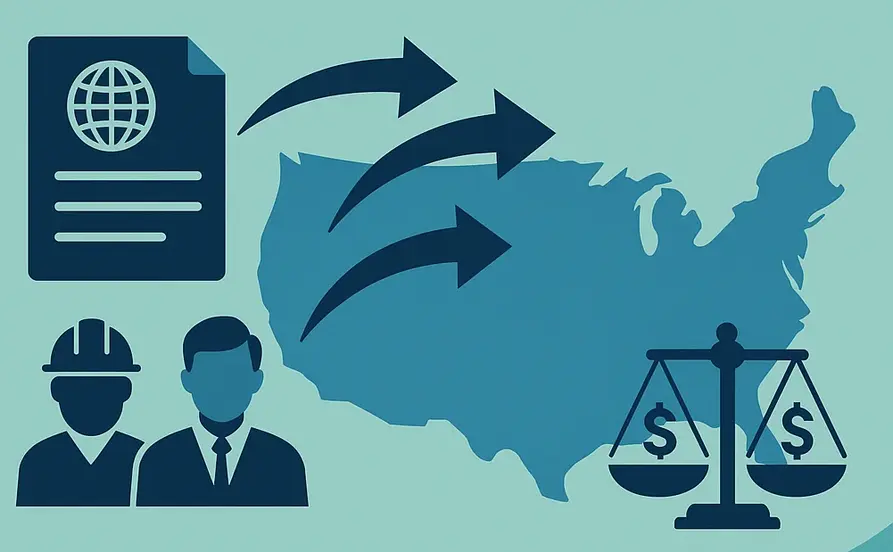In a surprising turn of events, the US labor market immigration impact is becoming increasingly evident as recent job reports reveal dramatic shifts in employment demographics. The June job numbers have exceeded market expectations, but with an unexpected twist: native-born American workers have accounted for all of these gains, while the number of foreign-born workers has declined significantly. This transformation coincides with enhanced border security measures and has far-reaching implications for wages, manufacturing revival, and the broader economic landscape.
Record Job Growth for Native-Born Americans Signals Market Shift
The latest employment data presents a compelling narrative about the US labor market immigration impact. Since January, the number of foreign-born workers has fallen by 543,000, while native-born workers have seen job gains of approximately two million in the same timeframe. This stark contrast represents one of the most significant demographic shifts in recent labor market history.
The Numbers Behind America’s Employment Transformation
Economic analysts point to these figures as evidence of a fundamental realignment in the US labor market immigration impact. The dramatic reduction in border crossings has created a labor environment where employers are increasingly turning to the domestic workforce to fill positions. This shift is particularly notable because it reverses a multi-year trend of reliance on immigrant labor across various sectors.
“A lot of it has to do with border security and the fact nobody is crossing the border,” notes one economic expert. This change in migration patterns has created immediate ripple effects throughout the economy, with businesses adapting their hiring and compensation strategies in response.
Border Security’s Direct Impact on Labor Demographics
The correlation between enhanced border security measures and changing employment demographics highlights the direct US labor market immigration impact of policy decisions. With significantly reduced illegal immigration, the labor market has begun to rebalance, creating new opportunities for American workers who may have previously faced competition from undocumented workers willing to accept lower wages.
This rebalancing effect is particularly visible in industries that have historically relied heavily on immigrant labor, including construction, agriculture, hospitality, and certain manufacturing sectors. Companies in these industries are now implementing new recruitment strategies and, in many cases, offering improved compensation packages to attract domestic workers.
Real Wage Growth Outpacing Inflation for the First Time in Years
Perhaps the most significant US labor market immigration impact for American workers is the effect on wages. According to recent data, wages for native-born workers have increased by approximately 4% year-on-year—a rate that is twice the current inflation rate. This represents real wage growth that puts more purchasing power in the hands of American workers.
“Real wages went down during the Biden years. Ordinary working folks lost money,” explains one analyst. “Now we’re seeing a reversal of that trend, with wages rising faster than inflation for the first time in years.” This wage growth is particularly meaningful for lower and middle-income workers who have historically been most vulnerable to wage depression from illegal immigration.
Manufacturing Renaissance: Revitalizing America’s Industrial Backbone
The US labor market immigration impact is particularly evident in the manufacturing sector, which has shown signs of revival after decades of decline. This renaissance represents not just an economic shift but a cultural revaluation of blue-collar work and its importance to American prosperity.
The Value of Blue-Collar Jobs in Today’s Economy
“I find it condescending when those on the left and even on the right say leave behind jobs and move everybody to white-collar work,” notes one commentator with personal connections to manufacturing. This sentiment reflects a growing recognition that manufacturing jobs provide essential economic opportunities and stability for millions of Americans.
The US labor market immigration impact has helped highlight the critical role these jobs play in creating middle-class prosperity. As competition from undocumented workers decreases, wages in manufacturing have begun to rise, making these careers more attractive to American workers seeking stable employment with good benefits.
Personal Stories: How Manufacturing Careers Create Generational Opportunity
The transformative power of manufacturing employment extends beyond individual workers to entire families and communities. “My mother-in-law worked in the same plant since she was a teenager, and it provided good pay, good benefits, and the opportunity to provide a better life for her kids,” shares one advocate for American manufacturing.
These personal testimonials illustrate the US labor market immigration impact at a human level. Manufacturing jobs have historically served as stepping stones to middle-class prosperity, enabling families to invest in education and opportunities for the next generation. “My husband was the first person in his family to graduate from college. That would not have been possible without that job,” the same advocate explains.
Policy Shifts Supporting American Manufacturing Growth
Recent policy changes aimed at reviving the American manufacturing base appear to be gaining traction. The US labor market immigration impact is just one factor in this broader effort to rebuild domestic production capacity. Additional measures, including targeted investments, trade policy adjustments, and workforce development initiatives, are working in concert to strengthen manufacturing communities.
“The Trump administration is taking seriously the need to revive the manufacturing base,” notes one observer. This focus represents a significant shift from previous approaches that often prioritized service sector growth while accepting manufacturing decline as inevitable in a globalized economy.
Legal Immigration’s Positive Role in Economic Development
While the reduction in illegal immigration has created positive effects for native-born workers, it’s important to recognize that legal immigration continues to play a vital role in economic growth. The US labor market immigration impact of properly managed legal immigration differs significantly from the effects of uncontrolled illegal immigration.
Creating Jobs Through Entrepreneurship: Immigrant Success Stories
Legal immigrants often become job creators themselves, establishing businesses that employ American workers. “My husband is a legal immigrant, has a concrete company in Nashville, Tennessee. What he’s been able to provide is jobs for Americans,” shares one commentator whose family exemplifies this positive US labor market immigration impact.
These entrepreneurial contributions highlight the distinction between managed, legal immigration that complements the domestic workforce and unregulated illegal immigration that can undermine wages and working conditions. “He loves it here. He loves the U.S. He is grateful to be here. He pays taxes. He is so fortunate,” the commentator adds about her immigrant husband.
The Distinction Between Legal and Illegal Immigration Impacts
Economic experts emphasize that the current discussion about the US labor market immigration impact should distinguish between different types of immigration. “Immigrants help make this country great,” notes one analyst. “Good to see rebalancing at the border so ultra-cheap labor, some call it slave labor, not taking away jobs from whatever, manufacturing or whatever.”
This nuanced perspective acknowledges both the positive contributions of legal immigrants and the potential negative effects of uncontrolled illegal immigration on wages and job opportunities for American workers. The goal of policy should be to maximize the benefits while minimizing the downsides.
Immigration System Challenges: Visa Delays and Economic Consequences
Despite the benefits of legal immigration, the current system faces significant challenges. The US labor market immigration impact of bureaucratic delays and inefficiencies in the visa and passport processes can prevent valuable contributors from entering the country legally.
“The problem is we are so screwed up with State Department and visa and passports it takes years for good people to come in here,” explains one commentator frustrated with the current system. These delays can harm economic growth by preventing businesses from accessing needed talent and entrepreneurs from establishing job-creating enterprises in the United States.
Regional Economic Benefits from Labor Market Rebalancing
The US labor market immigration impact varies significantly across different regions of the country. Rural and industrial communities that have struggled with economic decline in recent decades appear to be experiencing particularly notable benefits from the current labor market rebalancing.
Rural Communities Finding New Economic Vitality
“Agriculture community is heart and soul of rural community,” notes one congressman from Arkansas, highlighting the importance of stable employment and fair wages in these areas. The US labor market immigration impact in rural regions includes both challenges in securing seasonal agricultural labor and opportunities for long-term residents to secure better-paying positions.
As the labor market adjusts to reduced illegal immigration, agricultural businesses are implementing a variety of strategies, including mechanization, improved working conditions, and higher wages to attract workers. These changes, while challenging in the short term, may contribute to more sustainable rural economies in the long run.
How Every Sector Contributes to America’s Economic Strength
The current labor market transformation reflects a growing recognition that all types of work contribute valuable services to society. The US labor market immigration impact has helped highlight the essential nature of jobs across the economic spectrum, from manufacturing and agriculture to service industries and knowledge work.
“Every part is valued, not just cheap labor touted by upper East keyboard peddler of New York Times,” observes one commentator. “It’s more than coming together and saying we see and value every human that impacts food we eat and how we have electricity and plumbing and everything.”
Building an Economy That Values All Types of Work
This renewed appreciation for diverse forms of labor represents a significant cultural shift alongside the economic changes. The US labor market immigration impact has contributed to a reevaluation of what constitutes valuable work and fair compensation. Americans who “finally feel heard by this administration and seen and valued” are responding with increased economic participation and confidence.
This cultural dimension of the labor market transformation may prove as significant as the economic metrics. When workers feel their contributions are valued and fairly compensated, productivity and job satisfaction typically increase, creating positive feedback loops throughout the economy.
📢 Hiring? Post Jobs for Free with WhatJobs
Are you a business owner in manufacturing, construction, or any industry looking for dedicated American workers? Connect with qualified candidates ready to contribute to your company’s success. The evolving US labor market immigration impact opens the door to a growing pool of domestic talent seeking fair wages and strong benefits.
🚀 Post Your Job for FreeThe Path Forward: Balancing Security and Opportunity
As the American economy continues to adjust to changing immigration patterns, policymakers face the challenge of balancing border security with economic growth needs. The US labor market immigration impact will continue to evolve, requiring thoughtful approaches that protect American workers while allowing for beneficial legal immigration.
Streamlining Legal Immigration Processes
One clear area for improvement is the efficiency of legal immigration processes. Reducing backlogs and streamlining visa applications for qualified immigrants would help businesses access needed skills while maintaining the integrity of the immigration system. This balanced approach would maximize the positive US labor market immigration impact while minimizing negative effects.
Investing in American Worker Training
As employers adjust to a changing labor pool, investments in training and workforce development become increasingly important. Programs that help American workers develop skills for in-demand jobs can ease transition challenges and ensure businesses have access to the talent they need. These initiatives represent a proactive response to the US labor market immigration impact that benefits both workers and employers.
Maintaining Economic Momentum
The current positive trends in employment and wages suggest that the American economy is adapting successfully to the changing labor market dynamics. Continuing policies that support domestic manufacturing, fair wages, and appropriate immigration controls could help maintain this momentum. The US labor market immigration impact appears to be contributing to an economy that works better for ordinary Americans, a trend worth preserving and strengthening.
FAQ: Understanding the US Labor Market Immigration Impact
How has the recent decline in illegal immigration affected wages for American workers?
The US labor market immigration impact on wages has been significant, with data showing that native-born workers are experiencing wage growth of approximately 4% year-on-year—double the current inflation rate. This represents real wage growth that increases purchasing power for American workers. The reduction in competition from illegal immigrants willing to work for lower wages has created upward pressure on compensation, particularly in industries that previously relied heavily on undocumented labor. This wage effect is most pronounced for lower and middle-income workers who historically faced the most direct competition from illegal immigration.
Which industries are seeing the biggest changes due to the US labor market immigration impact?
The US labor market immigration impact is most visible in sectors that traditionally employed higher percentages of immigrant workers, both legal and illegal. Manufacturing has shown signs of revival, with increasing wages and job opportunities for American workers. Construction, agriculture, hospitality, and food service are also experiencing significant adjustments, with employers implementing new recruitment strategies and often offering improved compensation to attract domestic workers. These industries are adapting to the new labor market reality by investing in training, improving working conditions, and in some cases, accelerating automation to address labor shortages.
How does legal immigration differ from illegal immigration in its US labor market immigration impact?
Legal immigration and illegal immigration have distinctly different US labor market immigration impacts. Legal immigrants often become entrepreneurs who create jobs for Americans, pay taxes, and contribute to economic growth in structured, regulated ways. They frequently fill specific skill gaps or create new businesses that complement the existing economy. In contrast, illegal immigration can undermine wages and working conditions by creating an unregulated labor pool willing to work for below-market compensation. The current policy focus appears to be on maintaining pathways for beneficial legal immigration while reducing illegal border crossings that can negatively impact American workers’ wages and job opportunities.
What role does manufacturing play in the changing US labor market immigration impact?
Manufacturing plays a central role in the US labor market immigration impact story, with the sector experiencing something of a renaissance as labor market dynamics shift. Manufacturing jobs have historically provided stable, middle-class employment with benefits that enable generational advancement. As competition from undocumented workers decreases and policy support for domestic manufacturing increases, these jobs are becoming more accessible and attractive to American workers. The personal stories of families lifted into the middle class through manufacturing employment highlight the sector’s importance in creating economic opportunity and stability for communities across the country.
How are rural communities affected by the US labor market immigration impact?
Rural communities are experiencing both challenges and opportunities from the US labor market immigration impact. Agricultural regions face potential labor shortages for seasonal work previously performed by migrant workers, requiring adaptations in farming practices and compensation structures. However, many rural areas are also seeing benefits from manufacturing revivals and wage increases that improve economic conditions for long-term residents. The recognition that “agriculture community is heart and soul of rural community” reflects the importance of balancing immigration policies to support both agricultural viability and fair wages for workers in these regions.
What policy changes could maximize the positive aspects of the US labor market immigration impact?
To maximize the positive US labor market immigration impact, policymakers could focus on several key areas. First, streamlining legal immigration processes while maintaining border security would help businesses access needed skills and entrepreneurial talent. Second, investing in training and education for American workers would ease transition challenges as labor markets adjust. Third, targeted support for manufacturing and other industries creating middle-class jobs would help sustain the current positive trends in employment and wages. Finally, ensuring that immigration policies distinguish between beneficial legal immigration and problematic illegal immigration would help maintain public support for a balanced approach that serves America’s economic interests.




